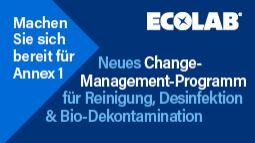- Trade fair
Energy efficiency in cleanrooms requires engineering expertise and state-of-the-art measurement technology
Cleanzone 2017
Energy optimisation in cleanrooms is a very demanding process, for it is essential that the energy-saving measures do not lead to a reduction in the precisely defined threshold values. Visitors will be able find examples of this at the cleanroom trade fair Cleanzone on Tuesday and Wednesday, 17 and 18 October 2017 in Frankfurt am Main.
Since a key factor is always the precise tasks at issue, the fundamental process is best demonstrated using an example from actual practice. For the case depicted here, the cleanroom experts began by taking note of the most important factors. For a pharmaceutical facility in which production is taking place under GMP conditions, the task was to set up cleanrooms of various classes (A/B, B, C, D) in an area of over 1,500 square meters while ensuring that there would be no cross-contamination, and also satisfying high cooling load requirements.
The external engineers worked closely with the future user to develop a range of concepts. During this process, the focus was on process-optimised planning that incorporated profitability analysis, with particular attention being paid to the ventilation and air-conditioning technology.
In the end, it was decided that it would be best to ventilate the cleanrooms using individual recirculation units with integrated heating and cooling registers. The intention was to install these in the intermediate ceiling area and equip them with terminal HEPA (High Efficiency Particulate Air filter) filtration systems. The individual recirculation units were to be fed proportionally with pre-treated fresh air. The plan also included a clever air-conditioning concept that incorporated heat recovery in the central ventilation unit while allowing for “free cooling” with the generation of cooling. In other words, when it is cold outside, this cold is utilised for cooling the air.
As a result, the cooling units can be turned off for a number of months each year – ensuring that the necessary pumping operations continue is all that is required. The concept that was implemented also made it possible to reduce the size of the central air conditioning unit by approx. 70 percent in comparison with a system in which the cleanrooms are ventilated and aerated directly. The use of individual heating and cooling units for each cleanroom makes it possible to regulate usage to suit requirements – and therefore helps optimise the energy use of the entire system. Due to the fact that such finely tuned control of the pressure differentials between ‘clean’ and ‘unclean’ areas is subject to continuous monitoring and adjustments, cross-contamination is precluded right from the start / i.e. is only possible as a result of gross negligence.
Energy savings such as those described here can generally be achieved in all industries where production is carried out in cleanrooms. After all, the overall cleanroom system can be viewed as a single unit – with numerous possibilities for fine tuning at various locations and points in the process. Regardless of the potential savings that can be achieved through ventilation and air conditioning technology, however, the size and class of the cleanroom are the primary determinants of the energy consumption. Because of this, process-optimised planning is necessary right from the start.
Johann Mößlacher, Professional Engineer at DITTEL Engineering, Ried, explains: “Here, optimisation involves a process of carefully determining where the limits lie. In cleanrooms in particular, this entails such things as reducing the air exchange rates, lowering the pressure differentials between individual zones, and defining processes for a lower cleanroom class. This can quickly give rise to a fear that certain standards, regulations and the threshold values mandated therein are being violated, and this often results in a tendency to over-engineer systems and facilities in order to be certain that all requirements are satisfied. Yet it is an engineer's job to question these very assumptions, so that they can design systems that comply with all necessary threshold values without exceeding them needlessly. That is the correct approach for optimising the energy consumption.”
Retroactively modifying existing cleanroom systems can also be a successful approach – as in ointment production, for example: a recirculation unit for low-turbulence displacement flow makes it possible to lower energy consumption by 32 percent by reducing the air flow speed from 0.45 to 0.20 metres per second during times when production is not taking place. The one-off costs of 11,000 euros for tests and qualification can lead to annual cost reductions of 6,000 euros – meaning the move pays for itself within two years.
It all comes down to making good use of the leeway that is almost always available. This entails continuously comparing target and actual figures and taking new technological possibilities into account. And it is critical to remember that conventional energy meters are not enough. In order to properly record the relevant data in cleanrooms, specialised cleanroom expertise is a must, for when this is done, it is possible – to give an example – to achieve savings of ten to twenty percent with existing systems and, in comparison with conventional ‘off the rack’ designs, as much as fifty percent for a brand new design that is precisely tailored to requirements.
The industry will be offering a clear demonstration of the fact that energy efficiency and high quality standards in cleanrooms do not have to be mutually exclusive at the Cleanzone trade fair on 17 and 18 October in Frankfurt am Main. For example, the “Measurement Technology: Equipment + Project Validation/Qualification” module of the Cleanzone Congress will be focusing on state-of-the-art measurement processes. Visitors to the Cleanzone trade fair this October will be able to obtain an information advantage and return to their own operations with concrete concepts and impressive examples from actual practice.
![]()
cleanzone
Messe Frankfurt Exhibition GmbH
Ludwig-Erhard-Anlage 1
60327 Frankfurt am Main
Germany
Phone: +49 69 75756290
Fax: +49 69 757596290
email: anja.diete@messefrankfurt.com
Internet: https://cleanzone.messefrankfurt.com








